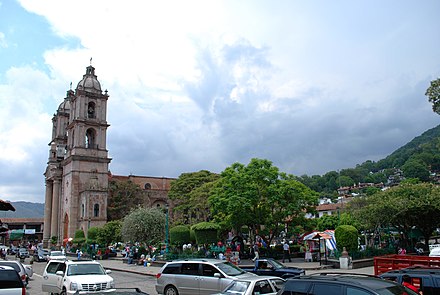Valle de Bravo
Valle de Bravo (American Spanish: [ˈbaʝe ðe ˈβɾaβo] (![]() listen)) is one of 125 municipalities in the State of Mexico, Mexico. The largest town and municipal seat is the town of Valle de Bravo. It is located on the shore of Lake Avándaro, approximately 156 km (97 miles) southwest of Mexico City and west of Toluca on highways 15, 134 or 1.[1] It takes about two hours to drive from Mexico City to Valle de Bravo, making it a popular weekend getaway for the capital's affluent upper class.
listen)) is one of 125 municipalities in the State of Mexico, Mexico. The largest town and municipal seat is the town of Valle de Bravo. It is located on the shore of Lake Avándaro, approximately 156 km (97 miles) southwest of Mexico City and west of Toluca on highways 15, 134 or 1.[1] It takes about two hours to drive from Mexico City to Valle de Bravo, making it a popular weekend getaway for the capital's affluent upper class.
The town has several names during its history including San Francisco del Valle de Temascaltepec, Temascaltepec de indios, Villa del Valle, and San Francisco del Valle. The original names including Temascaltepec caused confusion with the nearby "Real de Minas de Temascaltepec", now Temascaltepec, so the county was known as "El Valle" (The Valley).[2] The honorific "de Bravo" was added later to recognize Nicolás Bravo who fought at the Castle of Chapultepec during the Mexican–American War. Its Coat of arms includes the image of a temazcal in reference to its original name.[3]
In 1971, Valle de Bravo was known as typical city (ciudad típica) and magical town (pueblo mágico) in 2005. The town and the surrounding area are well known in Mexico as a tourist destination, mainly due to its relative proximity to Mexico City and for having hosted the world-famous Circuito Avandaro auto racing event and Festival de rock y Ruedas, a massive rock music festival.[4]
The first to arrive in the area were the Matlatzinca, who settled mostly in the present-day communities of Santa Maria Ahuacatlán, La Peña and Otumba. Between 1474 and 1479, the Aztec tlatoani Axayacatl conquered the region, establishing what would be the last addition to the Aztec Empire. After the destruction of Tenochtitlan by the Spanish, campaigns to subdue the area were carried out by Andrés de Tapia and Gonzalo de Sandoval, followed by evangelization by the Dominicans and the Augustinians. Around 1530, the Franciscan friar Gregorio Jiménez de la Cuenca founded the town as a congregation called "El Pino". Between 1607 and 1615, a Franciscan convent was established here, giving the town that grew up around it its original name of San Franciscano del Valle de Temascaltepec.[3]
The town suffered greatly during the Mexican War of Independence due to the monarchy's attempts to repress the rebellion there. Another short-lived rebellion occurred in 1834 when Carlos Guadalupe Tepixtoco Abad proclaimed his plan to re-establish the empire of Moctezuma. However, most people considered the cause to be ridiculous and the movement quickly died out. The village gained town status in 1842 and city status in 1878. In the beginning of the 19th century, Professor G. Velázquez wrote the poem "Valle de Bravo en la poesía de Pagaza", describing the region's beauty. The town also saw incursions by Zapatistas during the Mexican Revolution.[3]



